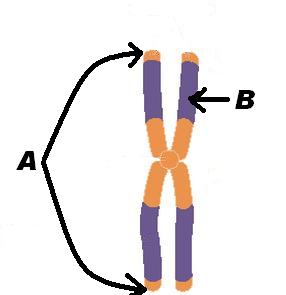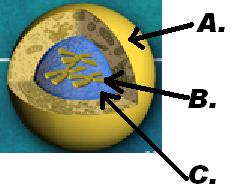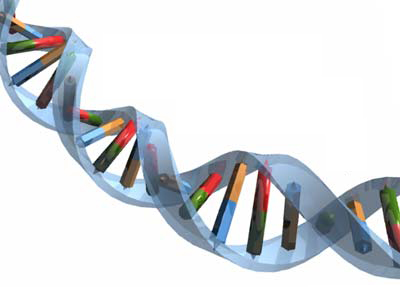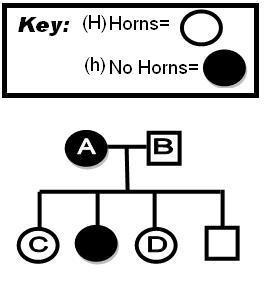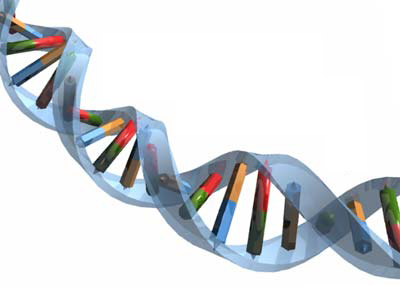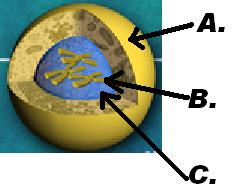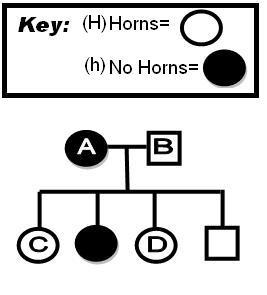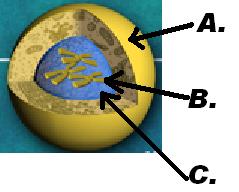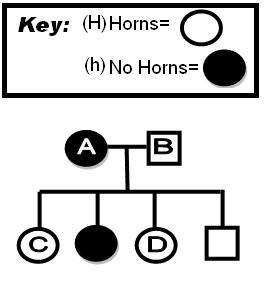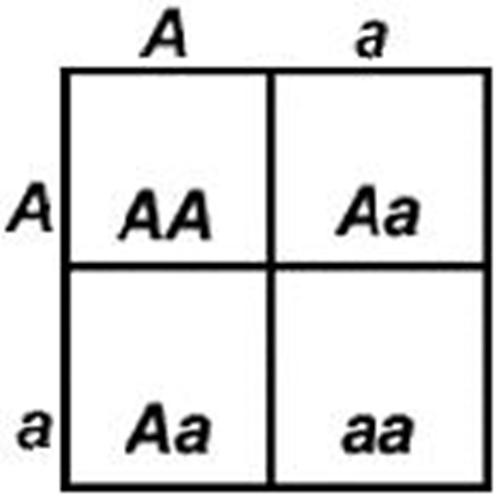John Glenn Genetics Test
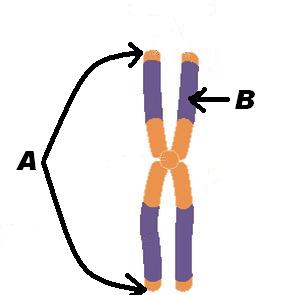
Students recall from topics: DNA, Meiosis, Punnett Squares, Dominance, Pedigrees, and Mutation.
- 1.
What is structure "A"?
- A.
Cell
- B.
Chromosome
- C.
Gene
- D.
Gametes
Correct Answer
B. ChromosomeExplanation
A chromosome is a structure that carries genetic information in the form of genes. It is found in the nucleus of cells and is responsible for the transmission of hereditary traits from one generation to the next. Chromosomes are made up of DNA and proteins and are visible under a microscope during cell division. They play a crucial role in determining an individual's characteristics and are passed on through gametes, which are reproductive cells involved in sexual reproduction.Rate this question:
-
- 2.
What is structure "B"?
- A.
Cell
- B.
Chromosome
- C.
Gene
- D.
Gametes
Correct Answer
C. GeneExplanation
Structure "B" refers to a specific component or entity. Among the options provided, a gene is the most appropriate answer as it is a fundamental unit of heredity and carries genetic information. Cells, chromosomes, and gametes are all related to genetics, but they are not specific structures themselves. Therefore, gene is the correct answer.Rate this question:
-
- 3.
If red flower color "R" is INCOMPLETELY DOMINANT over white flower color "r" then what would be the color of an individual with "Rr."
- A.
Red
- B.
White
- C.
Pink
Correct Answer
C. PinkExplanation
If red flower color "R" is incompletely dominant over white flower color "r," it means that when an individual has one copy of the red allele (R) and one copy of the white allele (r) (Rr), neither allele completely masks the other. In this case, the individual would exhibit a phenotype that is a blend of the two alleles, resulting in a pink color.Rate this question:
-
- 4.
What is it when one allele totally dominates over another allele?
- A.
Partial dominance
- B.
Complete dominance
- C.
Half dominance
- D.
Incomplete dominance
Correct Answer
B. Complete dominanceExplanation
Complete dominance occurs when one allele completely masks the expression of another allele in a heterozygous individual. In this case, the dominant allele is expressed phenotypically, while the recessive allele remains hidden. This results in a clear distinction between the two possible phenotypes, with no blending or intermediate expression observed.Rate this question:
-
- 5.
The weaker allele is:
- A.
Dominant
- B.
Recessive
- C.
Complete
- D.
Incomplete
Correct Answer
B. RecessiveExplanation
The weaker allele is recessive because in genetics, dominant alleles mask the effects of recessive alleles. This means that if an individual has one dominant allele and one recessive allele for a particular trait, only the dominant allele will be expressed. The recessive allele will only be expressed if an individual has two copies of it. Therefore, the recessive allele is considered weaker because its effects are only observed when it is present in both copies.Rate this question:
-
- 6.
What is the physical appearance (visual characteristics) of an organism?
- A.
Genes
- B.
Genetic material
- C.
Genotype
- D.
Phenotype
Correct Answer
D. PhenotypeExplanation
Phenotype refers to the physical appearance or visual characteristics of an organism. It encompasses all the observable traits such as height, eye color, hair color, and other physical features that are influenced by both genetic and environmental factors. Genes and genetic material play a role in determining the phenotype, but the phenotype itself refers to the actual physical manifestation of those genes. Therefore, phenotype is the correct answer as it directly relates to the physical appearance of an organism.Rate this question:
-
- 7.
What is structure "A"?
- A.
Nucleus
- B.
Cell Membrane
- C.
Chromosome
- D.
Mitochondria
- E.
Golgi Complex
Correct Answer
B. Cell MembraneExplanation
The structure "A" refers to the cell membrane. The cell membrane is a thin, flexible barrier that surrounds the cell and separates the internal environment of the cell from the external environment. It is composed of a lipid bilayer with embedded proteins that regulate the movement of substances in and out of the cell. The cell membrane is essential for maintaining the integrity and function of the cell.Rate this question:
-
- 8.
What are the basic units that pass on traits?
- A.
Genes
- B.
Cells
- C.
Nuclei
- D.
Meiosis
Correct Answer
A. GenesExplanation
Genes are the basic units that pass on traits. They are segments of DNA located on chromosomes within the cell nucleus. Genes contain the instructions for making proteins, which are responsible for the expression of traits. During reproduction, genes are passed from parents to offspring, determining the inherited characteristics. Therefore, genes play a crucial role in the transmission of traits from one generation to the next.Rate this question:
-
- 9.
What type of mutation adds to the DNA code?
- A.
Secretion
- B.
Inversion
- C.
Deletion
- D.
Insertion
Correct Answer
D. InsertionExplanation
Insertion is a type of mutation that adds extra nucleotides to the DNA code. This can occur during DNA replication when an extra base pair is inserted into the DNA sequence. As a result, the genetic code is altered, which can lead to changes in the protein produced by that gene. Insertion mutations can have significant effects on an organism's phenotype and can cause genetic disorders or diseases.Rate this question:
-
- 10.
What is this structure?
- A.
Amino Acids
- B.
Nucleotides
- C.
Rough ER
- D.
Nucleus
- E.
DNA
Correct Answer
E. DNAExplanation
DNA is the correct answer because it is a structure that contains genetic information in the form of genes. It is found in the nucleus of cells and plays a crucial role in the inheritance and functioning of living organisms. DNA is composed of nucleotides, which are the building blocks of this structure. Amino acids are the building blocks of proteins, and while they are important for cellular function, they are not the correct answer in this context. Rough ER is a cellular structure involved in protein synthesis, but it is not specifically related to DNA.Rate this question:
-
- 11.
What is this?
- A.
Pedigree
- B.
Punnett Square
- C.
Phenotype
- D.
Genetic Engineering
Correct Answer
B. Punnett SquareExplanation
A Punnett Square is a diagram used in genetics to predict the possible outcomes of a cross between two individuals. It is a visual representation of the possible combinations of alleles that can be inherited from each parent. By using Punnett Squares, scientists can determine the probability of certain traits or genetic disorders being passed on to offspring. Therefore, Punnett Square is the correct answer in this case.Rate this question:
-
- 12.
The stronger allele is:
- A.
Dominant
- B.
Recessive
- C.
Complete
- D.
Incomplete
Correct Answer
A. DominantExplanation
The correct answer is Dominant. In genetics, alleles are different forms of a gene that can occupy the same locus on a chromosome. Dominant alleles are expressed and mask the effects of recessive alleles when present. They determine the phenotype or physical characteristics of an organism. In contrast, recessive alleles are only expressed when there are no dominant alleles present. Complete and incomplete refer to types of dominance, where complete dominance occurs when the dominant allele completely masks the recessive allele, and incomplete dominance occurs when the heterozygous genotype results in a phenotype that is intermediate between the two homozygous genotypes.Rate this question:
-
- 13.
What is an allele?
- A.
Different forms of traits
- B.
Different forms of DNA
- C.
Different forms of genes
- D.
All of the above
Correct Answer
D. All of the aboveExplanation
An allele refers to different forms of a gene that can exist at a specific location on a chromosome. These different forms can result in variations in traits or characteristics expressed by an organism. Since genes are made up of DNA, and traits are determined by genes, all of the given options are correct explanations of what an allele is.Rate this question:
-
- 14.
How many females did these parents have?
- A.
1
- B.
2
- C.
3
- D.
4
Correct Answer
C. 3Explanation
The parents had three females.Rate this question:
-
- 15.
Create a Punnett square to cross two dragons with "Tt." What percentage of their offspring will be "Tt"?
- A.
25 %
- B.
50 %
- C.
75 %
- D.
100 %
Correct Answer
B. 50 %Explanation
When creating a Punnett square, you can determine the possible combinations of alleles that the offspring can inherit from their parents. In this case, since both dragons have a genotype of "Tt," they can each pass on either a "T" or a "t" allele to their offspring. When you create the Punnett square, you will see that there are four possible combinations: TT, Tt, tT, and tt. Out of these four combinations, two of them (Tt and tT) have the "Tt" genotype. Therefore, 50% of their offspring will have the "Tt" genotype.Rate this question:
-
- 16.
DNA is:
- A.
The code that allows for different forms of genes
- B.
The chemical code that is made of A, T, G, C
- C.
The genetic code that chromosomes are made of
- D.
All of the above
Correct Answer
D. All of the aboveExplanation
DNA is all of the above because it is the code that allows for different forms of genes, it is the chemical code that is made of A, T, G, C, and it is also the genetic code that chromosomes are made of. DNA carries the instructions for the development, functioning, and reproduction of all living organisms. It is responsible for the inheritance of traits and plays a crucial role in determining an organism's characteristics.Rate this question:
-
- 17.
What type of mutation removes the DNA code?
- A.
Secretion
- B.
Inversion
- C.
Deletion
- D.
Insertion
Correct Answer
C. DeletionExplanation
Deletion is a type of mutation that removes a section of the DNA code. This means that a portion of the genetic material is lost or deleted from the DNA sequence. Deletions can vary in size, ranging from a single nucleotide to large segments of DNA. This type of mutation can have significant effects on the functioning of genes and can lead to genetic disorders or diseases.Rate this question:
-
- 18.
"Hh" is an example of an organism's:
- A.
Genotype
- B.
Phenotype
- C.
Chromosome
- D.
Pedigree
- E.
Punnett Square
Correct Answer
A. GenotypeExplanation
"Hh" is an example of an organism's genotype because it represents the genetic makeup of the organism. In this case, "Hh" indicates that the organism has two different alleles for a particular gene. The lowercase "h" represents a recessive allele, while the uppercase "H" represents a dominant allele. The genotype determines the traits that an organism inherits and can pass on to its offspring.Rate this question:
-
- 19.
Create a Punnett Square to cross "Rr" and "Rr." Red flower color "R" is INCOMPLETELY DOMINANT over white flower color "r." What is the phenotypic ratio?
- A.
Red: 1 White: 3
- B.
Red: 2 White 2
- C.
Red: 0 Pink: 2 White: 2
- D.
Red: 1 Pink: 2 White: 1
Correct Answer
D. Red: 1 Pink: 2 White: 1Explanation
When crossing "Rr" and "Rr", the Punnett Square shows that there is a 25% chance of getting a red flower (RR), a 50% chance of getting a pink flower (Rr), and a 25% chance of getting a white flower (rr). Therefore, the phenotypic ratio is Red: 1, Pink: 2, White: 1.Rate this question:
-
- 20.
What are the pairs that make up this structure?
- A.
V-Z , G-C
- B.
A-Z , G-O
- C.
V-T , O-C
- D.
A-T , G-C
Correct Answer
D. A-T , G-CExplanation
The given pairs represent the base pairs in DNA structure. A-T and G-C are complementary base pairs, with adenine (A) always pairing with thymine (T) and guanine (G) always pairing with cytosine (C). This is a fundamental principle in DNA structure and replication.Rate this question:
-
- 21.
How many chromosomes do humans have?
- A.
6 chromosomes
- B.
18 chromosomes
- C.
23 chromosomes
- D.
46 chromosomes
Correct Answer
D. 46 chromosomesExplanation
Humans have 46 chromosomes. Chromosomes are thread-like structures made of DNA that carry genetic information. They are found in the nucleus of every cell in our body. Humans have 23 pairs of chromosomes, with one set inherited from each parent. Each pair consists of two chromosomes, one from the mother and one from the father, making a total of 46 chromosomes. This includes 22 pairs of autosomes and one pair of sex chromosomes (XX for females and XY for males). The correct answer is 46 chromosomes.Rate this question:
-
- 22.
Create a Punnett Square to cross a male "XY" and a female "XX." What percentage of the offspring will be "XY"?
- A.
0 %
- B.
25 %
- C.
50 %
- D.
75 %
Correct Answer
C. 50 %Explanation
When crossing a male "XY" with a female "XX" in a Punnett Square, the possible combinations of alleles are "XX" and "XY". Since only one out of the two possible combinations results in an "XY" genotype, the percentage of offspring that will be "XY" is 50%.Rate this question:
-
- 23.
If two dragons that are "Tt" for tail genes are crossed and "T" is COMPLETELY DOMINANT over 't", what ratio of their offspring will have no spikes. (TT-spikes, Tt-spikes, tt-no spikes)
- A.
0:4
- B.
1:4
- C.
2:4
- D.
3:4
Correct Answer
B. 1:4Explanation
When two dragons that are "Tt" for tail genes are crossed, they can produce offspring with different combinations of tail genes. In this case, "T" is completely dominant over "t", which means that if an offspring inherits at least one "T" gene, it will have spikes. Only if an offspring inherits two "t" genes will it have no spikes. Therefore, out of the possible combinations of tail genes (TT, Tt, tt), only one combination (tt) will result in no spikes. The ratio of offspring with no spikes to those with spikes is 1:4.Rate this question:
-
- 24.
What is structure "C"?
- A.
Nucleus
- B.
Cell Membrane
- C.
Chromosome
- D.
Mitochondria
- E.
Golgi Complex
Correct Answer
A. NucleusExplanation
The structure "C" refers to the nucleus. The nucleus is a membrane-bound organelle found in eukaryotic cells. It contains the cell's genetic material, which is organized into chromosomes. The nucleus controls the cell's activities and is responsible for the storage, replication, and transmission of genetic information.Rate this question:
-
- 25.
What is the genotype of "A"?
- A.
Horns
- B.
No Horns
- C.
HH
- D.
Hh
- E.
Hh
Correct Answer
D. HhExplanation
The genotype of "A" is hh. This is because the options provided represent different genotypes for the presence or absence of horns. "HH" represents the genotype for having horns, "hh" represents the genotype for not having horns, and "Hh" represents the genotype for being a carrier for horns. Since the question specifically asks for the genotype of "A" and the only option that represents not having horns is "hh", it can be concluded that the correct answer is hh.Rate this question:
-
- 26.
What is it when the genes in a pair seem to blend together?
- A.
Heterozygous
- B.
Homozygous
- C.
Complete Dominance
- D.
Incomplete Dominance
Correct Answer
D. Incomplete DominanceExplanation
Incomplete dominance occurs when the phenotype of a heterozygous individual is an intermediate blend of the phenotypes of the two homozygous individuals. In this case, the genes in the pair do not completely dominate or mask each other, resulting in a new phenotype that is a combination or blend of the two.Rate this question:
-
- 27.
What is structure "B"?
- A.
Nucleus
- B.
Cell Membrane
- C.
Chromosome
- D.
Mitochondria
- E.
Golgi Complex
Correct Answer
C. ChromosomeExplanation
Chromosome is the correct answer because it is a structure that contains genetic material and is responsible for carrying the hereditary information of an organism. It is found in the nucleus of a cell and plays a crucial role in cell division and passing on genetic traits to offspring. The other options, such as Nucleus, Cell Membrane, Mitochondria, and Golgi Complex, are different cellular structures with their own distinct functions, but they do not specifically refer to the structure "B" mentioned in the question.Rate this question:
-
- 28.
What process produces gametes (egg and sperm)?
- A.
Mitosis
- B.
Fertilization
- C.
Meiosis
- D.
Sterilization
Correct Answer
C. MeiosisExplanation
Meiosis is the correct answer because it is the process that produces gametes (egg and sperm). During meiosis, a single cell undergoes two rounds of division, resulting in the formation of four haploid cells. These haploid cells are the gametes, which have half the number of chromosomes as the parent cell. This process is essential for sexual reproduction and ensures genetic diversity in offspring.Rate this question:
-
- 29.
What is the genotype of "C"?
- A.
Horns
- B.
No Horns
- C.
HH
- D.
Hh
- E.
Hh
Correct Answer
E. HhExplanation
The genotype of "C" is Hh because it is a heterozygous combination of the dominant allele (H) for horns and the recessive allele (h) for no horns.Rate this question:
-
- 30.
The martian has "purple ears" is an example of a martian's:
- A.
Genotype
- B.
Phenotype
- C.
Pedigree
- D.
Punnett Square
Correct Answer
B. PhenotypeExplanation
The term "phenotype" refers to the observable characteristics or traits of an organism, which are determined by both its genetic makeup (genotype) and environmental factors. In this case, the fact that the martian has "purple ears" is a visible trait or characteristic, making it an example of a phenotype.Rate this question:
-
- 31.
Dragon's have 6 chromosomes. How many chromosomes are in one egg?
- A.
1
- B.
2
- C.
3
- D.
6
Correct Answer
C. 3Explanation
The question states that dragons have 6 chromosomes. However, it does not specify whether the number of chromosomes in an egg is the same as in a dragon. Therefore, we cannot assume that the number of chromosomes in an egg is 6. Since the question does not provide any additional information, we cannot determine the exact number of chromosomes in one egg. Therefore, the answer is 3, as it is the only option that is not based on an assumption.Rate this question:
-
- 32.
Which is heterozygous?
- A.
BB
- B.
Bb
- C.
Bb
Correct Answer
B. BbExplanation
The term "heterozygous" refers to an individual having two different alleles for a particular gene. In this case, the correct answer is Bb because it represents a genotype with one dominant allele (B) and one recessive allele (b). The other options, BB and bb, represent individuals that are homozygous, meaning they have two identical alleles for the gene.Rate this question:
-
- 33.
Which is homozygous recessive?
- A.
BB
- B.
Bb
- C.
Bb
Correct Answer
C. BbExplanation
In genetics, the term "homozygous recessive" refers to an individual who carries two copies of the same recessive allele for a particular gene. In this case, the genotype "bb" represents homozygous recessive because both alleles are lowercase "b," indicating the recessive trait. The uppercase "B" represents the dominant allele, so genotypes "BB" and "Bb" would be homozygous dominant and heterozygous, respectively.Rate this question:
-
- 34.
Which is homozygous dominant?
- A.
BB
- B.
Bb
- C.
Bb
Correct Answer
A. BBExplanation
The genotype BB is homozygous dominant because both alleles are the same and dominant, resulting in the expression of the dominant trait.Rate this question:
-
- 35.
What percentage of offspring are heterozygous?
- A.
25 %
- B.
50 %
- C.
75 %
- D.
100 %
Correct Answer
B. 50 %Explanation
In genetics, heterozygous refers to having two different alleles for a particular gene. When two heterozygous individuals mate, there is a 50% chance that their offspring will inherit one allele from each parent, resulting in them being heterozygous. Therefore, the percentage of offspring that are heterozygous is 50%.Rate this question:
-
Quiz Review Timeline +
Our quizzes are rigorously reviewed, monitored and continuously updated by our expert board to maintain accuracy, relevance, and timeliness.
-
Current Version
-
Mar 21, 2023Quiz Edited by
ProProfs Editorial Team -
Feb 05, 2009Quiz Created by
Gettym0000
 Back to top
Back to top



